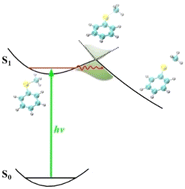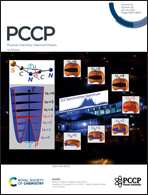Nonadiabatic heavy atom tunneling in 1nσ*-mediated photodissociation of thioanisole
Abstract
The 1nσ*-mediated photodissociation dynamics of thioanisole is investigated quantum mechanically using a three-dimensional model based on a newly constructed diabatic potential energy matrix. The lifetimes of the low-lying S1(1ππ*) resonances are determined and found to accord well with available experimental data. Specifically, our theoretical results demonstrate that the photodissociation of thioanisole at the low-lying S1(1ππ*) levels takes place via the heavy atom tunneling due to the higher S1/S2 conical intersection and two equivalent out-of-plane saddle points appearing on the dissociation path. The isotopic effect on the lifetimes is found to be pronounced, manifesting the nature of the tunneling process. Moreover, the geometric phase effect around the S1/S2 conical intersection is found to slightly impact the lifetimes due to the weak destructive or constructive interferences in this heavy atom tunneling, which differs significantly from the scenario in the nonadiabatic hydrogen atom tunneling. Importantly, the quantum mechanical treatment is essentially required to accurately describe the 1nσ*-mediated photodissociation dynamics of thioanisole owing to involving quantum tunneling and geometric phase effects near the conical intersection.



 Please wait while we load your content...
Please wait while we load your content...